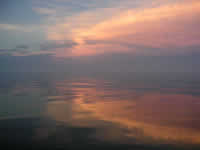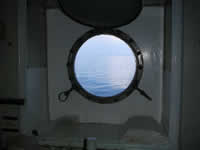


|
The Project Part 1: Part 2: Part 3:
|
31 July, 2005
|
 Great form, Angel!  Dolphins  Sunset, 7/31/05  Can you measure this port hole? |
Late last evening we saw some sort of bioluminescence off the side of the ship; it looked sometimes like pinpricks or streaks of light sliding quickly by the side. Angel suspects they were “jellies,” jellyfish that were signaling perhaps because of the disturbance caused by the passing of the ship.
Today the work continues. More samples are taken with the CTD and the Go-Flo. Everyone is busy filtering the water. Angel occasionally goes on deck and does a handstand, just for fun. The sea is like a sheet of glass, hot and blue. There is no wind and the sun scorches our skin in minutes. During the afternoon, a pod of pilot whales feeds off the bow. Dolphins jump on all sides of the boat.
More from The Log from the Sea of Cortez
A new kind of porpoise began to appear, gray, where the northern porpoise had been dark brown. They were slim and very fast, the noses long and paddle-shaped. They move about in large schools, jumping out of the water and seeming to have a very good time. The abundance of life here gives one an exuberance, a feeling of fullness and richness. The playing porpoises, the turtles, the great schools of fish which ruffle the water surface like a quick breeze, make for excitement. The sea here swarms with life.
What Steinbeck called a porpoise was most likely a dolphin. There is only one native species of porpoise in the Gulf of California, which is called the vaquita, or “little cow,” in Spanish. These animals are an endangered species; in fact, they are on the brink of extinction. It is thought that there are approximately 500 remaining. Vaquitas are the smallest cetaceans in the world and live only in the northern part of the Gulf close to the shore in the Colorado River delta. They are rarely seen, and sometimes perish when they are caught in gill nets.
There are over 900 islands in the Gulf; yesterday we passed several, both large and small. They look hot and barren, inhabited only by seabirds. We think they are volcanic in origin, but we’re not sure. There are volcanoes on the Baja Peninsula and the Mexican mainland. The two tectonic plates that meet under the Sea of Cortez continue to spread apart, widening the distance between the peninsula and the mainland.
The Gulf of California was created 4-6 million years ago when the American and Pacific plates slid past each other in a cataclysmic rupture. The San Andreas Fault is part of this system. The Baja Peninsula was separated from the mainland and formed the second longest peninsula in the world. (Only the Malay Peninsula is longer.)
Tonight the sunset is gorgeous; the camera cannot capture the depth of the color. The sea is flat calm and reflects the sunset. Sky and water bleed together, forming one entity.
Math Problem:
The glass in the port hole measures 42 centimeters in diameter. Can you calculate the area of a circle? What’s the area of the port hole? What’s its circumference?
On a ship, why are port holes always round? Read the answer tomorrow.
Trivia Tidbit of the Day:
Whales have no sense of smell, but they have good eyesight and a well-developed sense of taste.
![]()
